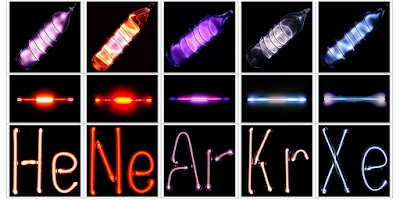 |
| Art @Nick Gindraux |
But I always felt the element of what color or the exact explanation of how the bolts work was somewhat lacking. Red for the common or normal bolts, green for good ones, blue for ionized for use against bots, etc. I don't care, I don't know shit about Star Wars, sorry.
Obviously it doesn't matter, given its a movie or whatever, but I like to think of their implementation in setting if you wanted to copy them for something else. This suddenly gave me an idea.
Blaster Colors by Noble Gas
The color of a blaster bolt is based on whatever noble gas is used to fill it; after all, they are energized plasma bolts of gas, so the same principles of neon lights apply here. Pure gases are usually used by matter of convenience and because it looks cooler, even though you could realistically get almost any color by combining them.
Why use noble gases instead of a more common gas? Simple; they don't react to things. This makes them ideal for blaster ammunition, as they won't suddenly oxidize the inside of the gun barrel or try to molecular-bond with each other while being charged.
Now you may think that this means each gas-color is really unique and has some really specific function, but no, I actually think it's cooler if they don't. Instead, their molecular mass is the most important aspect, and greatly influences their properties like flight speed, accuracy, how much heat it produces, and how much energy from the firing mechanism they can store. The more energy is applied to the bolt, the stronger its heat and explosive effects will be.
Helium bolts (yellow) are super lightweight, and as such fly the fastest and are extremely accurate, but do almost no damage. At low power settings they're ideal for training and target shooting; getting hit by one is like a spitball. At high power, they scatter the molecules too fast to be of much explosive use, but rapidly pushing out air can still knock lightweight objects out of the air, meaning they're used for sport shooting and shooting down fast moving targets like drones or small animals for game hunting without destroying the meat or pelt. Continuous beam style blasters also use this because it generates the least waste heat; you can use these for your mining lasers.
Xenon bolts are the opposite, ultra-heavy atomically and slow, most effected by gravity and wind resistance giving them a slight spread, but are very powerful. The blue bolts are synonymous with stun bolts used at low power settings, which is like getting slapped with a ton of wet blankets, but are so slow a skilled human might actually be able to dodge these with a head start and a diving leap. At high power settings? Become explosive and blow the fuck out of fortifications and used against heavily armored vehicles and orbital bombardment; being more synonymous with artillery. Use these for your blaster grenade launchers.
The colors in-between are on this spectrum; Neon (red) are fast and accurate enough to be used for sniping and low power enough to be used for handheld weapons without melting the gun in your hands or blowing a hole through the inside hull of a ship. White-Blue Krypton bolts are used for heavily armored targets and vehicles who might be too fast for a Xenon bolt to hit easily, like aircraft or spaceships. Argon bolts are right in the middle, being a perfect purple middle ground that's most used by scouts, raiders, and player-characters since they have no idea if they're going to be shooting at regular people or a rancor and need options.
In D&D terms? Blasters probably do like 4d6 damage or something. But maybe;
|
Gas |
To-Hit Bonus |
Damage Bonus |
Color |
|
Helium |
+2 |
-4 |
Yellow-Orange |
|
Neon |
+1 |
-2 |
Red |
|
Argon |
0 |
0 |
Purple |
|
Krypton |
-1 |
+2 |
White-Blue |
|
Xenon |
-2 |
+4 |
Blue |


this is a sweet idea, thanks for writing this up!
ReplyDelete